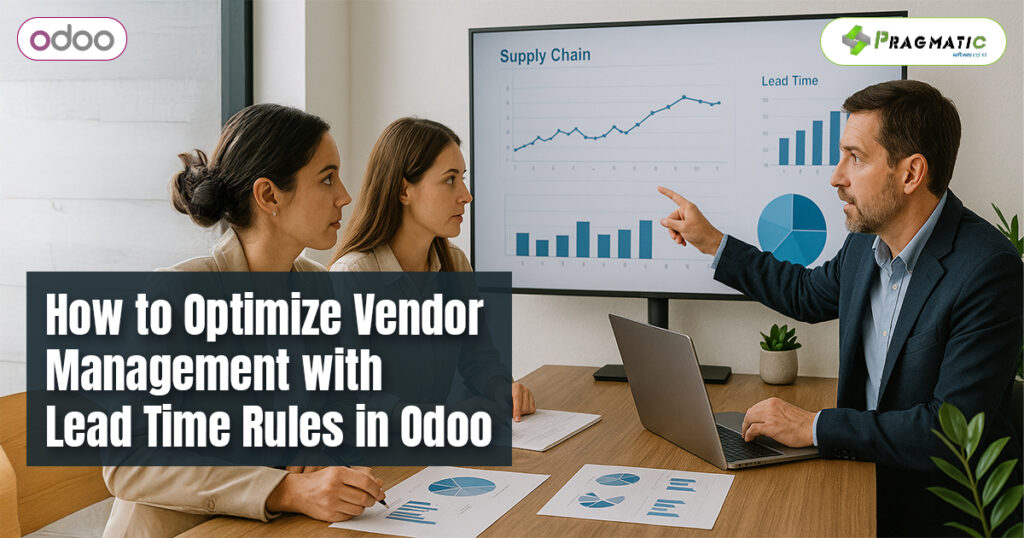

Effective vendor management has always been a cornerstone of successful supply chain operations. In 2025, with persistent global supply chain challenges and increasing customer expectations, optimizing vendor processes is more critical than ever. Businesses using Odoo can gain a competitive advantage by leveraging vendor lead time rules, vendor reliability analysis, and automated sourcing in Odoo 18.
In this guide, we’ll explore how to streamline your supply chain with Odoo vendor lead time management features in version 18. We’ll cover how to configure vendor lead times, assess vendor reliability, and use automated sourcing logic to make smarter purchasing decisions — ensuring you stay ahead in today’s fast-paced marketplace.
Lead time — the period between placing a purchase order and receiving the goods — directly impacts inventory levels, customer satisfaction, and operational costs. In Odoo 18, vendor lead time management has been enhanced to give supply chain managers greater visibility and control.
With accurate lead time rules and vendor performance metrics, businesses can:
As procurement challenges persist globally in 2025, utilizing these tools is no longer optional — it’s essential.
Odoo 18 makes it easier than ever to define vendor-specific lead times. Configuring these lead times ensures your system knows how many days to expect between ordering and delivery for each product-vendor combination.
1. Access Product Settings:
2. Add Vendor Information:
3. Account for Buffer Days:
4. Accounting for Transit Time:
By defining lead time rules meticulously, your procurement schedules and demand forecasting become significantly more reliable.
Odoo 18 introduces refined tools to evaluate vendor reliability, an essential measure for risk mitigation. Lead time isn’t valuable unless it’s reliable. Luckily, Odoo helps monitor this with Vendor Ratings and performance tracking.
1. Go to *Purchases* > *Configuration* > *Settings*.
2. Enable the Vendor Rating feature.
3. Choose criteria to track:
Every time a PO is fulfilled, Odoo can compare the actual delivery date to the promised lead time. Reliable vendors will have lower deviation scores.
In 2025, many businesses are creating internal benchmarks — like rating vendors as “Gold,” “Silver,” and “Bronze” — based on their average fulfillment time deviation. This is fully customizable in Odoo’s reporting tools or via custom dashboards.
Combining Odoo’s analytic capabilities with real-time data ensures you are not only buying from the lowest-cost vendor but the best-performing one.
Proactive alternate sourcing is a trend gaining momentum in 2025. Businesses are looking to reduce single-vendor dependency by automating switching when primary suppliers fail to deliver on time or quality.
Odoo 18 integrates alternate vendor logic intelligently into reordering rules.
1. Under each Product > *Purchase* tab, list multiple vendors.
2. Assign priorities or use Odoo’s auto-evaluation to dynamically choose vendors by:
This way, your system adjusts to real-world changes without manual intervention — crucial in 2025’s volatile supply chain environment.
Once lead times are properly configured, they feed into your demand planning and forecasting. Odoo’s MRP and Inventory modules use these figures to project when products will arrive — influencing manufacturing schedules, fulfillment timelines, and customer promises.
Odoo 18 now supports advanced AI and machine learning modules. Pairing these with clean lead time data allows predictive models to:
Businesses using Odoo 18 with AI integrations report up to 30% improvement in stock optimization by end Q1 2025, according to recent user feedback in the Odoo Community.
Here are some quick tips to improve your procurement strategy:
Effective vendor lead time management has quickly become a vital piece of a robust procurement strategy. Odoo 18’s enhanced capabilities now provide the tools you need to go beyond basic purchasing — enabling responsive, data-driven vendor management.
By configuring vendor lead times, tracking delivery reliability, and automating smart sourcing with Odoo 18, businesses can minimize risks, reduce backorders, and deliver a better customer experience even amidst uncertainty.
Want hands-on help optimizing your vendor workflows in Odoo? Our team of Odoo experts helps companies like yours unlock the full potential of Odoo with customized solutions.
Let’s talk about how we can streamline your procurement process.
Leave a Reply
You must be logged in to post a comment.